When gender transition appears in manga and anime, it is often the result of a supernatural ability or used a comedic plot device. The popular title Ranma ½ centers on a cursed character whose body switches to female when touched by cold water, and back to male when touched by hot water. How do these stories reinforce the ‘man in a dress’ trope, while stories like Revolutionary Girl Utena often show women who dress like men in a way that deconstructs gender roles? How does the use of this supernatural ability further remove cisgender readers from the realities of trans girls and women?
Visual Representation is a three-part series that will examine some of the trans characters that have appeared in comic books, manga, and webcomics. In this second entry, Tash Wolfe examines trans women’s representation in Ranma ½, Sailor Moon, and Wandering Son. You can also check out part one, Trans Characters in Comics.
The Spring of the Drowned Girl
As part of my research for this story, I connected with trans youth to discover where they saw themselves represented in manga and many of the youth brought up concerns about the character Ranma Saotome. Ranma ½, a long-running manga, was adapted into an 143-episode anime in 1989 that spawned three films and thirteen specials. In 1993, the anime became one of the first licensed by Viz Media and was dubbed for North American audiences. Ranma ½ was cited as a long-time fan favourite and a classic by Anime News Network. In the first chapter, Here’s Ranma, the Tendo household learns that the father’s old friend, Genma Saotome and his son Ranma will be visiting them from China. The father Soun hopes that Ranma will marry one of his daughters, even though he has not yet met Ranma. The family is excited when Ranma arrives, but Soun realizes that something is off when he gives Ranma a hug. His daughter Nabiki pokes at Ranma’s breast and tells the others, “’He’s is a girl.” 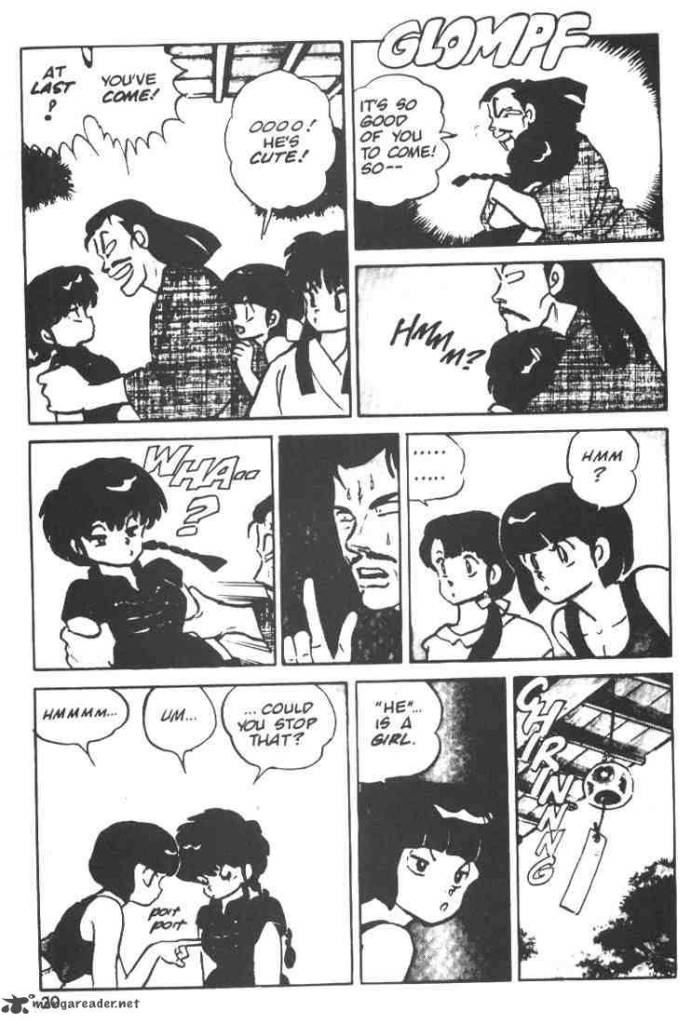 Nabiki becomes angry at Soun for not checking whether Ranma was actually a boy. She harasses Ranma by grabbing at his breasts. Akane, another of Soun’s daughters, acts differently than her sister and invites Ranma to be her friend. Earlier in the chapter, Akane wears a Karate gi and breaks a piece of wood on bricks in several pieces. After Nabiki comments to Akane that boys will think she is weird, Akane replies, “Not everyone thinks the world revolves around boys.”
Nabiki becomes angry at Soun for not checking whether Ranma was actually a boy. She harasses Ranma by grabbing at his breasts. Akane, another of Soun’s daughters, acts differently than her sister and invites Ranma to be her friend. Earlier in the chapter, Akane wears a Karate gi and breaks a piece of wood on bricks in several pieces. After Nabiki comments to Akane that boys will think she is weird, Akane replies, “Not everyone thinks the world revolves around boys.” 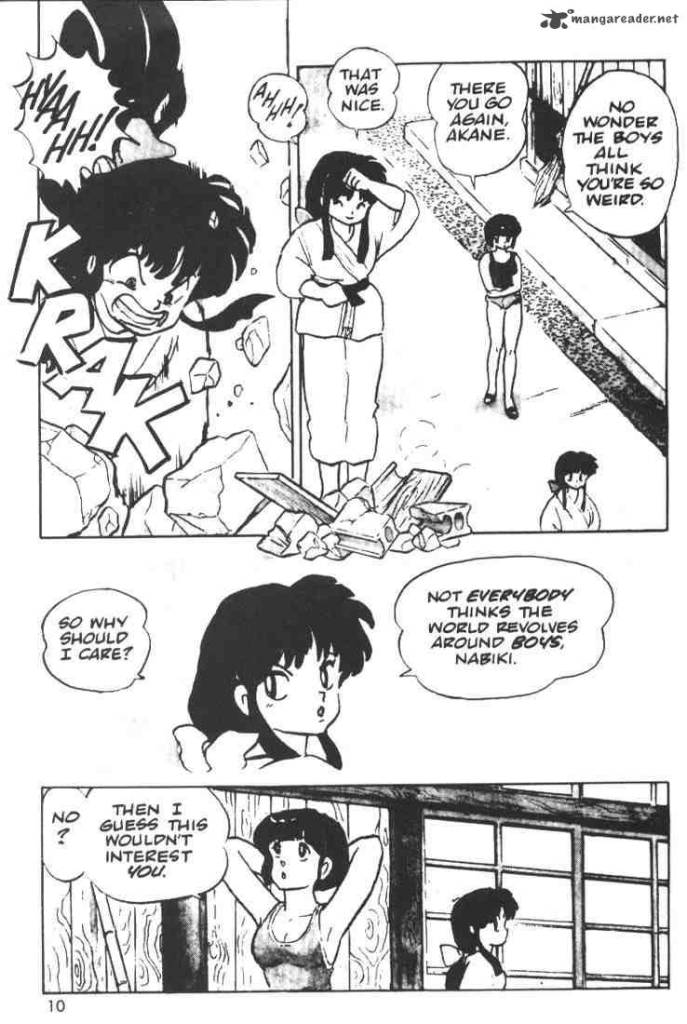
Akane and Ranma practice karate together and Ranma wins the match. Akane tells him that she is glad Ranma is a girl because she would hate to lose to a boy. Ranma is asked if she wants to have a bath and Ranma refuses. After being pressured, he agrees and decides to introduce himself to the family as his male self after the bath. Meanwhile, Akane also decides to have a bath. She slides open the bathroom door to find Ranma drying himself off. 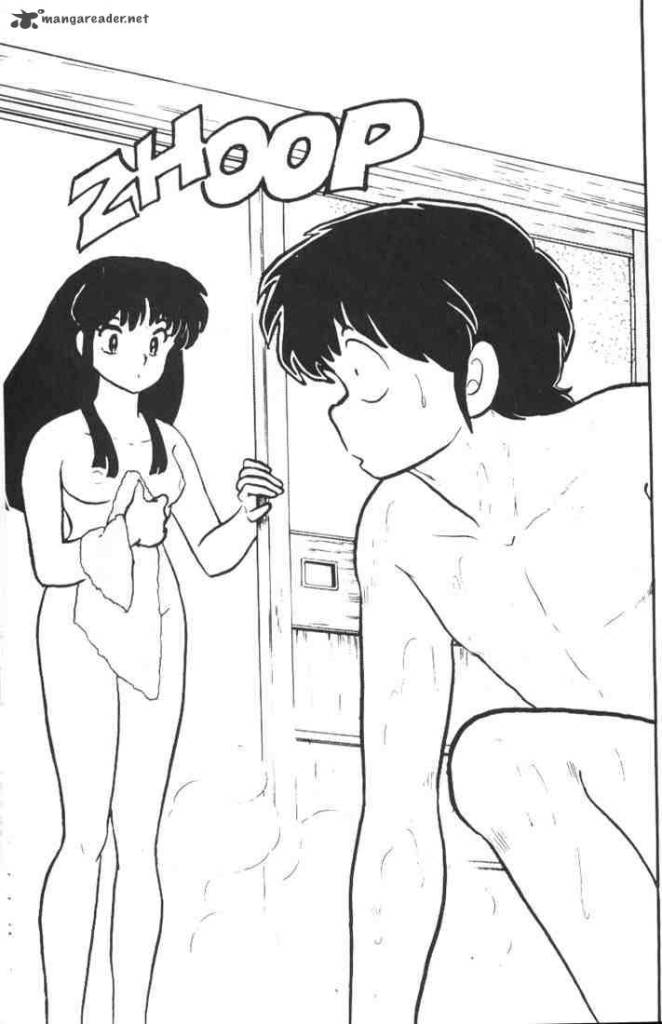 Akane panics, believing that there is a pervert in the bathroom. She screams and alerts the rest of her family. The girls turn to see Ranma standing next to them. He tells them that he is Ranma Saotome and apologizes to them.
Akane panics, believing that there is a pervert in the bathroom. She screams and alerts the rest of her family. The girls turn to see Ranma standing next to them. He tells them that he is Ranma Saotome and apologizes to them. 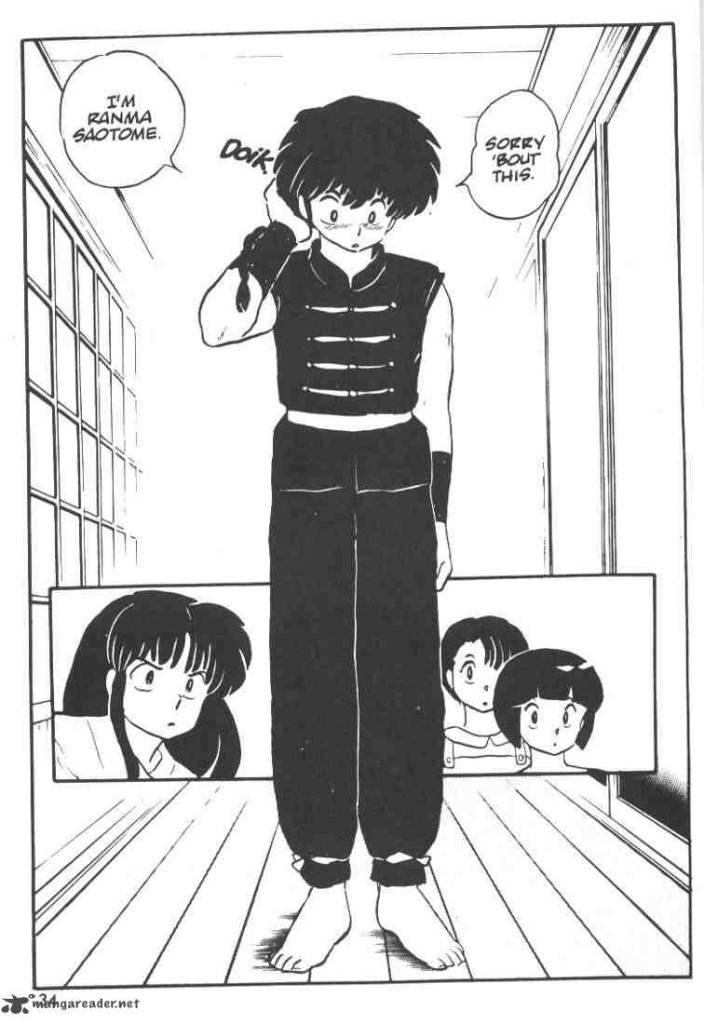 Genma arrives to the house and re-introduces Ranma to the Tendo family. Kasumi, the third daughter, asks if Ranma was really the girl who was with them earlier. As a way to explain the situation, Genma pushes Ranma into a cold pond which transforms Ranma into a girl again. When Ranma reappears out of the water, Genma cries out of humiliation. He explains Ranma’s secret to the family: The father and son visited China to train at the legendary “Training Ground of the Accursed Spring.” The guide at the spring warned them that the spring was no longer used as it is very dangerous and that each of the springs has their own legends. Genma falls into a spring and reappears out of the water as a panda. The guide explains that a panda had drowned in the spring 2000 years ago and that whoever falls in the spring will take the body of a panda. Ranma falls into the “Spring of the Drowned Girl” and takes on the body of a girl. After explaining the secret to the Tendo family, Genma and Ranma fall into a slapstick pattern of turning each other from man to panda and boy to girl.
Genma arrives to the house and re-introduces Ranma to the Tendo family. Kasumi, the third daughter, asks if Ranma was really the girl who was with them earlier. As a way to explain the situation, Genma pushes Ranma into a cold pond which transforms Ranma into a girl again. When Ranma reappears out of the water, Genma cries out of humiliation. He explains Ranma’s secret to the family: The father and son visited China to train at the legendary “Training Ground of the Accursed Spring.” The guide at the spring warned them that the spring was no longer used as it is very dangerous and that each of the springs has their own legends. Genma falls into a spring and reappears out of the water as a panda. The guide explains that a panda had drowned in the spring 2000 years ago and that whoever falls in the spring will take the body of a panda. Ranma falls into the “Spring of the Drowned Girl” and takes on the body of a girl. After explaining the secret to the Tendo family, Genma and Ranma fall into a slapstick pattern of turning each other from man to panda and boy to girl. 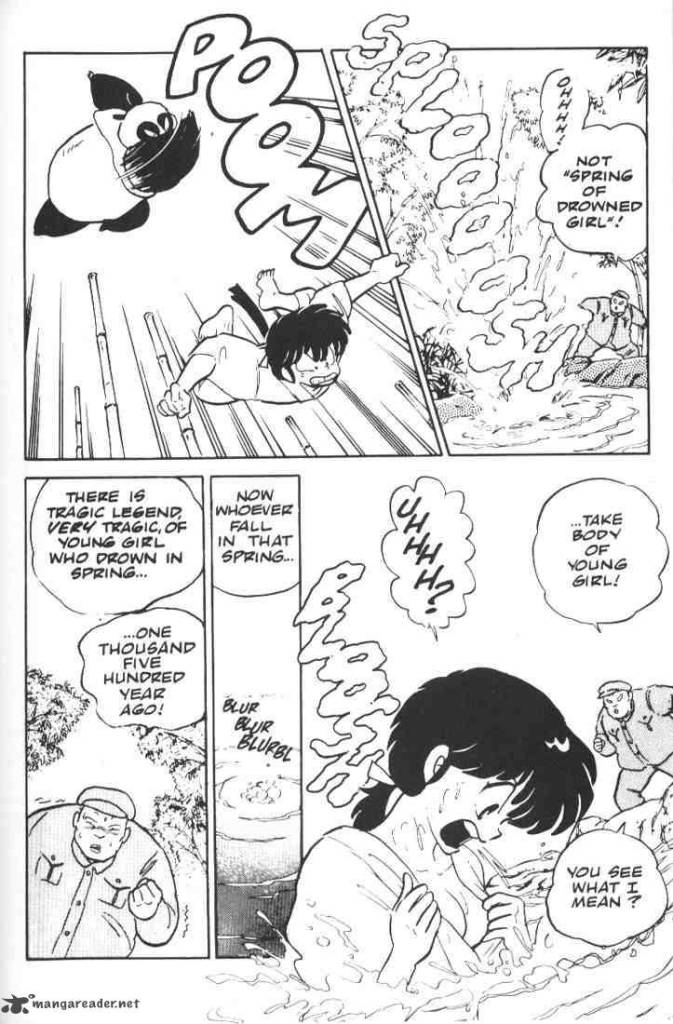 Soun tells Genma that Ranma would still be able to marry one of his daughters. Nabiki and Kasumi decide that Akane should be Ranma’s finacee, but Akane disagrees. The sisters tell Akane that Ranma would be perfect for her as he is “half-girl.” Both Ranma and Akane reject the proposed engagement, but their awkward love-hate friendship continues through the series.
Soun tells Genma that Ranma would still be able to marry one of his daughters. Nabiki and Kasumi decide that Akane should be Ranma’s finacee, but Akane disagrees. The sisters tell Akane that Ranma would be perfect for her as he is “half-girl.” Both Ranma and Akane reject the proposed engagement, but their awkward love-hate friendship continues through the series. 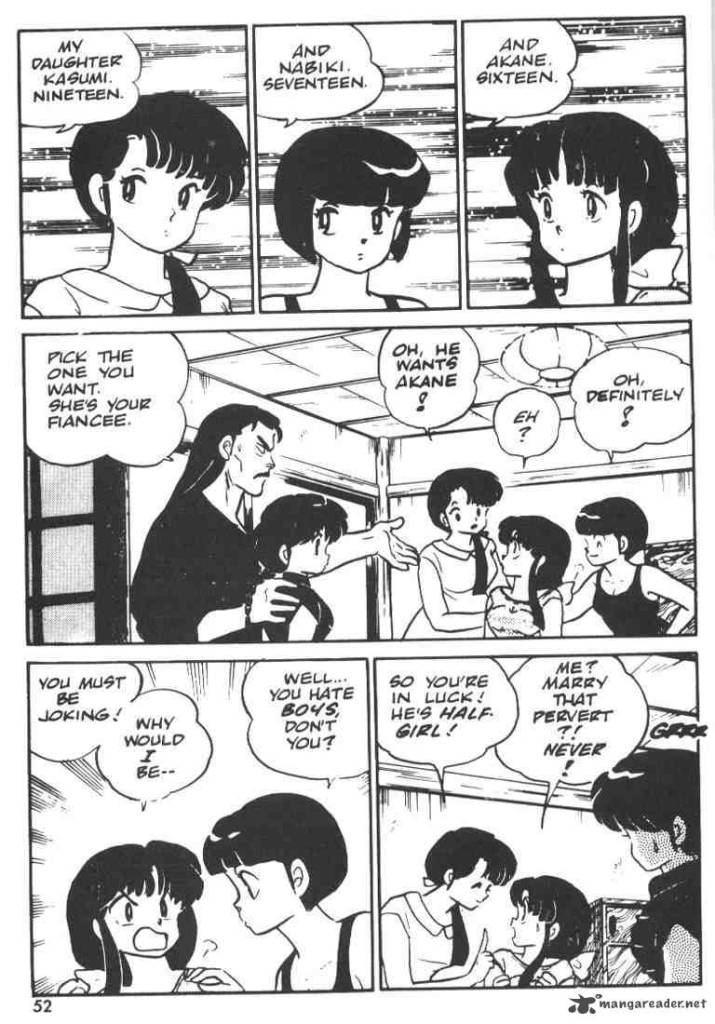 Rather than exploring any of the perspectives or experiences that Ranma had when living as a woman, the series focuses on how Ranma often uses his curse to advance his goals through karate competition. Ranma in cursed form becomes a love interest of the same characters that he fights as a boy. Other cursed characters are introduced with their cursed forms – one, a piglet – used to reinforced the comedic value of Ranma’s state as a girl.
Rather than exploring any of the perspectives or experiences that Ranma had when living as a woman, the series focuses on how Ranma often uses his curse to advance his goals through karate competition. Ranma in cursed form becomes a love interest of the same characters that he fights as a boy. Other cursed characters are introduced with their cursed forms – one, a piglet – used to reinforced the comedic value of Ranma’s state as a girl.
While it is likely that the creators did not intend trans representation through the character, it is an example of the “trans women trickery” trope that is often depicted in many stories, movies, and television shows.
Gender shouldn’t matter
Not long after North American audiences were introduced to Ranma Saotome, Sailor Moon exploded. The story was transformed into a franchise, spawning a 200-episode anime series, three movies, merchandise, and just under 30 musicals produced in Japan. We are going to jump to the third story arc of the Pretty Soldier Sailor Moon manga, which was adapated into the Sailor Moon S anime. A warning to Susana Polo and readers of her Sailor Moon newbie recaps — we don’t want to spoil you!
The series revolves around Sailor Moon and the Sailor Senshi (Mercury, Mars, Jupiter, and Venus) using their magical powers to fight monsters. Before they became Sailor Scouts, the five soldiers were everyday schoolgirls. This piece of their identities is maintained throughout the series – they crush on cute people, bicker, and study for their classes together. There is also an excellent storyline about the Moon Princess and eternal love, but I recommend checking out the manga and anime for that piece. Instead, we will focus on Haruka Tenou (Sailor Uranus). Haruka first appears in Act 27 driving a race car while a character describes him as “the first genius racer in a long time that Japan can be proud of.” He is dating Michiru Kaio, a young violinist who is also introduced in the act and who is later revealed as Sailor Neptune.
Our protagonist Usagi (Sailor Moon) meets Haruka in her favourite arcade where playing a racing game, while wearing a helmet and his school uniform. Michiru enters the scene and, after Usagi leaves, she jokes with Haruka about the two of them seeing friendly together. She smirks back, asks Michiru if she is jealous. Mamoru comments that the two newcomers are wearing Mugen Academy uniforms.  Mamoru (Tuxedo Kamen) notices that Huruka and Michiru were wearing Mugen Academy uniforms. The academy becomes the setting for the attacks by the newest enemy. During a fight, the Sailor Scouts notice two possible new sailor soldiers hiding in the shadows. Minako (Sailor Venus) becomes suspicious of Haruka and Michiru after Haruka warns Usagi that the academy is a dangerous place. When the Usagi and friends find Haruka practicing judo, Makoto (Sailor Jupiter) challenges him to a match. Haruka beats Makoto, causing Usagi to ask him how he could dare to throw a frail girl full-force. Haruka tells her that gender shouldn’t matter.
Mamoru (Tuxedo Kamen) notices that Huruka and Michiru were wearing Mugen Academy uniforms. The academy becomes the setting for the attacks by the newest enemy. During a fight, the Sailor Scouts notice two possible new sailor soldiers hiding in the shadows. Minako (Sailor Venus) becomes suspicious of Haruka and Michiru after Haruka warns Usagi that the academy is a dangerous place. When the Usagi and friends find Haruka practicing judo, Makoto (Sailor Jupiter) challenges him to a match. Haruka beats Makoto, causing Usagi to ask him how he could dare to throw a frail girl full-force. Haruka tells her that gender shouldn’t matter. 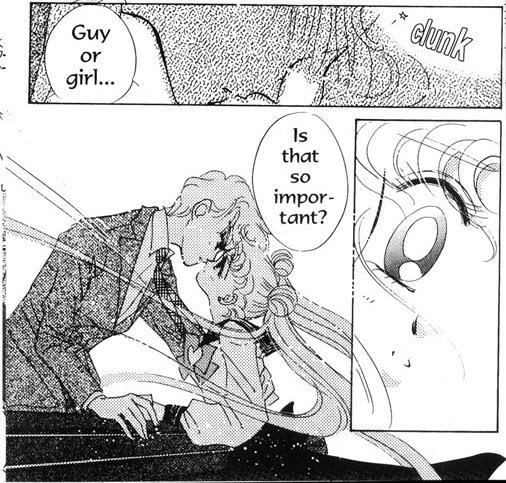 Usagi begins to realize that Haruka is one of the new Sailor Scouts. After a battle with the enemy, she spots the scout, recognizes her face, and chases after her. The scout calls Usagi ‘Dumpling-chan’ and kisses her. When the two reunite later at the arcade, Usagi observes that Haruka looks like a guy and looks like a girl too. She feels a desire to know more about Haruka. It seems that Usagi has developed a new crush.
Usagi begins to realize that Haruka is one of the new Sailor Scouts. After a battle with the enemy, she spots the scout, recognizes her face, and chases after her. The scout calls Usagi ‘Dumpling-chan’ and kisses her. When the two reunite later at the arcade, Usagi observes that Haruka looks like a guy and looks like a girl too. She feels a desire to know more about Haruka. It seems that Usagi has developed a new crush. 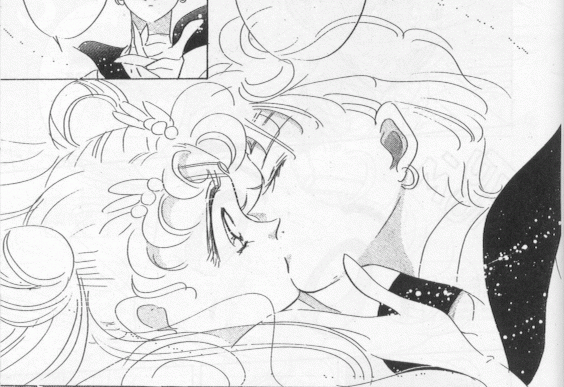 When Haruka and Michiru reveal their Sailor Scout identities to the other scouts, Usagi asks Haruka if he is Sailor Uranus. “If it were possible,” he responds, “I would have wanted you to only see me like this without you knowing anything more.” Usagi asks him if he is a man or a woman and he answers, “Man or a woman… is it really that important?” Later, Michiru explains to Usagi that Sailor Uranus is both male and female — “She is the Guardian who possesses the strengths of both genders.”
When Haruka and Michiru reveal their Sailor Scout identities to the other scouts, Usagi asks Haruka if he is Sailor Uranus. “If it were possible,” he responds, “I would have wanted you to only see me like this without you knowing anything more.” Usagi asks him if he is a man or a woman and he answers, “Man or a woman… is it really that important?” Later, Michiru explains to Usagi that Sailor Uranus is both male and female — “She is the Guardian who possesses the strengths of both genders.” 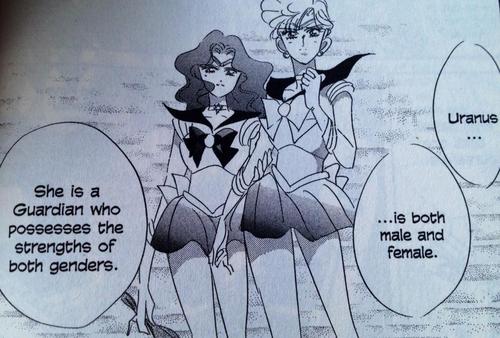 Haruka and Michiru’s relationship remains a focus of speculation. In both the manga and the anime, they are portrayed as a couple throughout the storyline, but they were portrayed as cousins in the North American English dub that was released in the 2000s. This erasure of queerness was not limited to these two characters – Zoisite, a villain from the first story arc was changed to a female character because of his romantic relationship with another male character.
Haruka and Michiru’s relationship remains a focus of speculation. In both the manga and the anime, they are portrayed as a couple throughout the storyline, but they were portrayed as cousins in the North American English dub that was released in the 2000s. This erasure of queerness was not limited to these two characters – Zoisite, a villain from the first story arc was changed to a female character because of his romantic relationship with another male character.
Luckily, the DiC translations are being updated with the new dubbed release of the anime, allowing Haruka and Michiru to be reintroduced to North Amercian audiences as a queer couple. While Haruka’s trans identity is not further explored in the manga, it is interesting how the character was transformed for North American audiences. Haruka is characterized as a teenaged girl who is sometimes mistaken for being male. His clothing moves between masculine and feminine outfits and is often described as a ‘tomboy’ with her bigender identity not referenced outside of the manga. Although Haruka was not written as a ‘trans character,’ he is noted as an inspiration and role model for many readers and viewers while swimming through the fluidity of their own genders.
Wandering Son
The series Wandering Son has been noted as one of the few manga to take trans identities seriously. The story revolves around Shuichi Nitori, a young student who identifies as a girl, and Yoshino Takatsuki, a young student who identifies as a boy. The story follows these two characters as they encounter the realities of growing up as a gender that does not fit with them, including body changes and life expectations. Shuichi is an introverted fifth-grader who is keeping the secret that she wants to be a girl.
When she transfers to a new school, she is mistaken for her sister by one of the teachers. She notices a classmate named Yoshino, who seems a bit different, like herself. The two of them study at Yoshino’s house and Shuichi becomes enamored by a dress hanging in Yoshino’s closet. Shuichi comments that the dress would look good on Yoshino, who flips the idea and tells her that it would look good on Shuichi as well. Yoshino suggests that Shuichi brings the dress home for her sister. Shuichi and her sister share a room and Shuichi stares at the dress hanging in the closet. She has a nightmare about being caught trying on the dress. 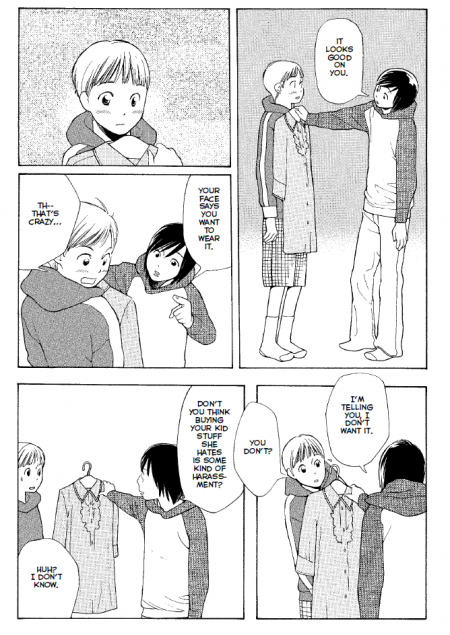 When Yoshino offers to give Shuichi more outfits to take home to her sister, a classmate jokes that Yoshino would never wear the outfits himself. Another classmate makes a joke about Shuichi wearing the dress and suddenly the focus is moved onto Shuichi and how she would look in the dress. The classmate notices that Shuichi already looks like a girl with her hairband that she had put on. Yoshino defends Shuichi, knowing that the pressure was bothering her. On her way home from Yoshino’s house, Shuichi buys her own hairband. The next day, she wears it to school and around the house when her mother is not around. She tries on the dress as the door rings. It is her classmate.
When Yoshino offers to give Shuichi more outfits to take home to her sister, a classmate jokes that Yoshino would never wear the outfits himself. Another classmate makes a joke about Shuichi wearing the dress and suddenly the focus is moved onto Shuichi and how she would look in the dress. The classmate notices that Shuichi already looks like a girl with her hairband that she had put on. Yoshino defends Shuichi, knowing that the pressure was bothering her. On her way home from Yoshino’s house, Shuichi buys her own hairband. The next day, she wears it to school and around the house when her mother is not around. She tries on the dress as the door rings. It is her classmate. 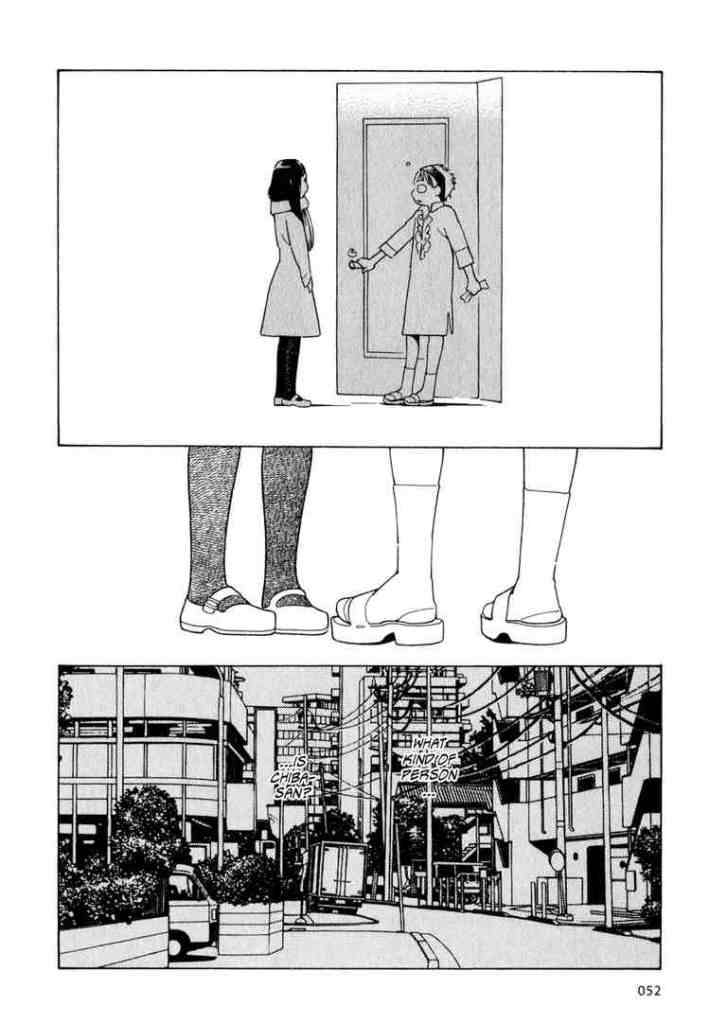 Yoshino and Shuichi both get their hair cut. Yoshino asks for his hair to be cut really short and Shuichi asks for her only her bangs to be trimmed. Afterwards, Yoshino tells Shuichi that Shuichi looks more like a girl than she does. Yoshino dreams of being able to wear a boy’s school uniform. With his new haircut, he visits a restaurant where he won’t be recognized and is hit on by a girl. In his head, he cheers.
Yoshino and Shuichi both get their hair cut. Yoshino asks for his hair to be cut really short and Shuichi asks for her only her bangs to be trimmed. Afterwards, Yoshino tells Shuichi that Shuichi looks more like a girl than she does. Yoshino dreams of being able to wear a boy’s school uniform. With his new haircut, he visits a restaurant where he won’t be recognized and is hit on by a girl. In his head, he cheers.  Yoshino confides in Shuichi that he sometimes likes to wear the boy’s school uniform. She starts to ponder on this as her classmates push her more into being feminine. One day, Yoshino asks her if she is someone who wants to be a girl.
Yoshino confides in Shuichi that he sometimes likes to wear the boy’s school uniform. She starts to ponder on this as her classmates push her more into being feminine. One day, Yoshino asks her if she is someone who wants to be a girl. 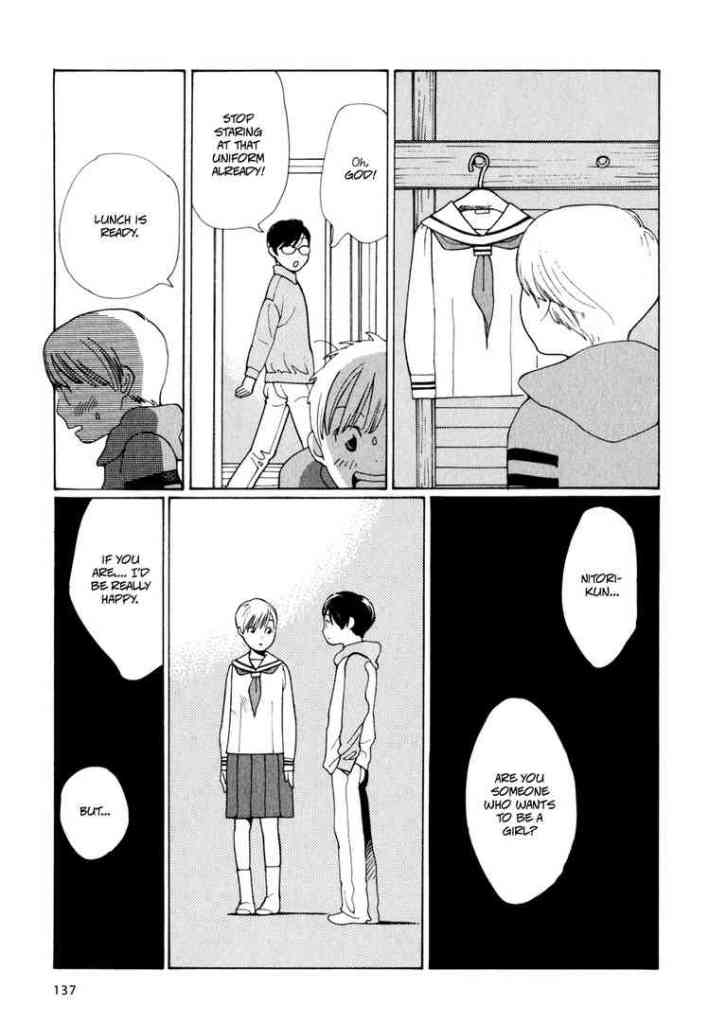 Yoshino dresses Shuichi up and they visit a neighboring town together dress as themselves. Yoshino encourages Shuichi to use the women’s washroom for the first time. She sits in the stall, convincing herself that she is strong.
Yoshino dresses Shuichi up and they visit a neighboring town together dress as themselves. Yoshino encourages Shuichi to use the women’s washroom for the first time. She sits in the stall, convincing herself that she is strong. 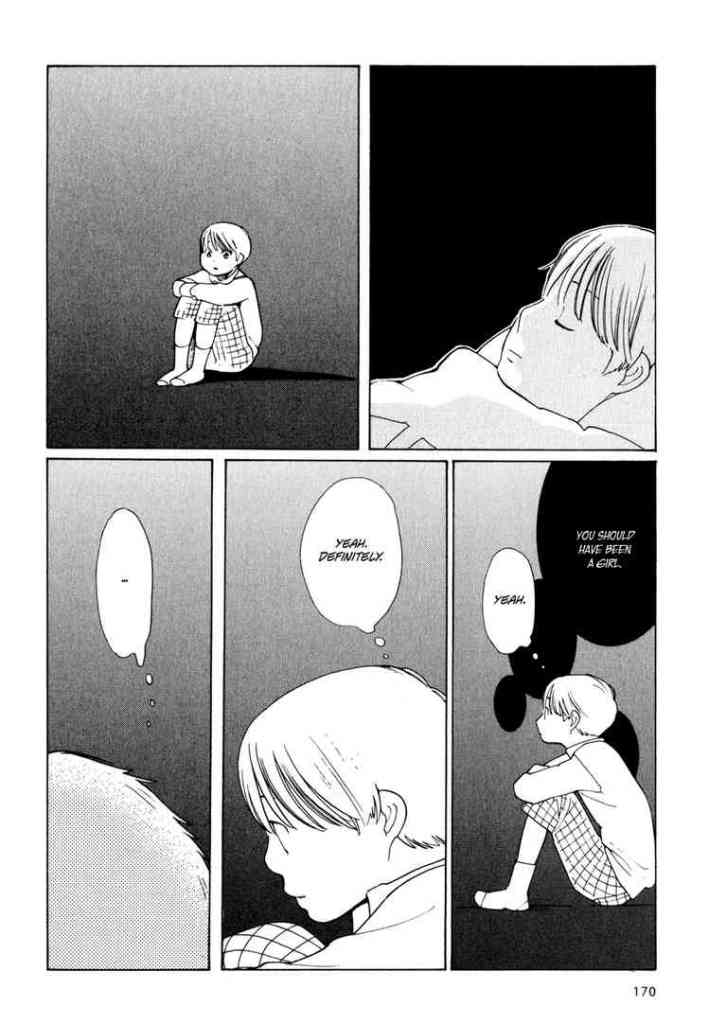 Shuichi begins to feel ‘seen’ under the mentorship of Yoshino, who is also finding his identity throughout this story. I do not want to explain too much of the storyline, as it is a beautiful piece to experience on your own. The two children connect with other gender creative children, creating a new sense of community in a place filled with rigid gender roles and expectations.
Shuichi begins to feel ‘seen’ under the mentorship of Yoshino, who is also finding his identity throughout this story. I do not want to explain too much of the storyline, as it is a beautiful piece to experience on your own. The two children connect with other gender creative children, creating a new sense of community in a place filled with rigid gender roles and expectations.
The story follows them into junior high where Shuichi begins to fall for Yoshino, while Yoshino continues to piece together his gender identity. Puberty is thrown into the mix with Yoshino experiencing his first monthly bleeding and Shuichi struggling with body hair and his deepening voice.
Wandering Son provides us with a beautiful story about gender creative children that follows them into their adolescence. One of the few complaints that I have heard about this story was when it wrapped up after an eleven-year run. Readers were not ready to let go of these characters and ached to experience them as adults. The characters spend much of the story not being able to present as their true selves. This is a common story for many gender creative children and trans youth who hide who they are because of a lack of supportive family members or friends. As well, the story highlights the differences between the individual access that Shuichi and Yoshino have in exploring gender — Shuichi is teased for her femininity while Yoshino is labelled as a ‘tomboy’ and has an easier time fitting in.
It is refreshing to see characters engaging with the ways that trans girls are treated in society, rather than creating characters that further reinforce trans-misogynistic stereotypes.
Tash Wolfe is a femme zinester who writes about grunge kids growing up queer in the 1990s. Her writing on trauma is featured in university courses on sexuality and social justice in literature. She spends her time re-reading Sailor Moon manga and knitting lace scarves for friends. You can find her on Twitter and Ravelry @jewellerytears. Are you following The Mary Sue on Twitter, Facebook, Tumblr, Pinterest, & Google +?








